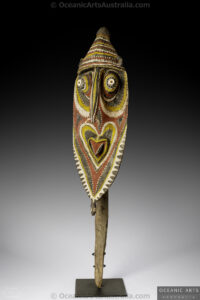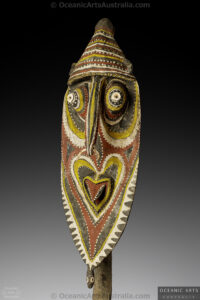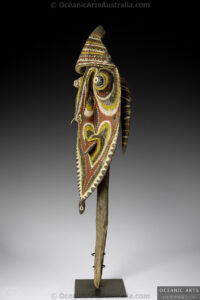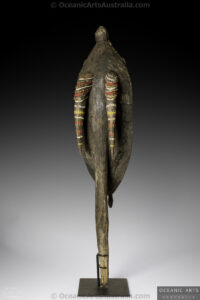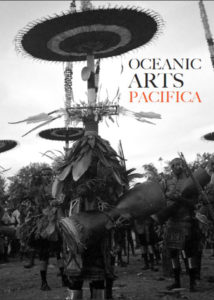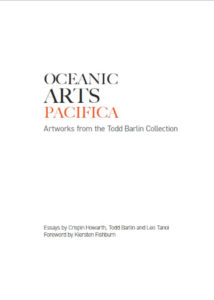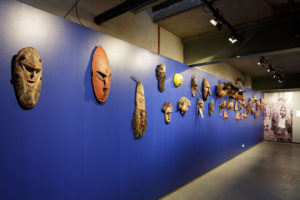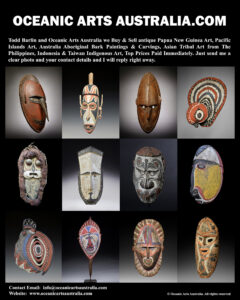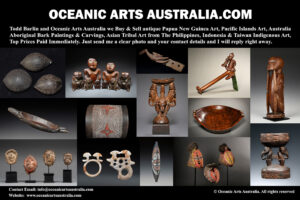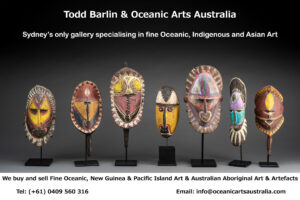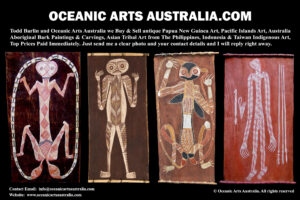A Superb Old New Guinea Yina Figure Kwoma People Waskuk Area Upper Sepik River Papua New Guinea
| Collection No. | TB-1652 |
|---|---|
| Size | Height 155cm x 35cm wide |
A Superb Large Yina Ceremonial Figure is from the Kwoma People in the Waskuk Area on the Upper Sepik River area of Papua New Guinea.
The Kwoma people and their closely related neighbors the Nukuma and Manambu share a unique tradition revolving around the cultivation of yams. An annual series of rituals associated with the yam harvest ensures the tuber’s continuing abundance and renders it suitable for human consumption. Clans sponsor the events, which are staged in a sequence of three rituals each involving different types of figures.
Yina is one of three distinct ceremonies held annually in the villages of the Kwoma, Nukuma, and Mayo speakers of the Upper Sepik River, in a region generally referred to as the Waskuk Hills. These ceremonies are associated with fertility and the harvesting of yams and the spiritual well-being of their communities.
There are two other Yam Harvest Ceremonies that are associated with a distinctive form of sculpture, Minja & Nogkwi, which specific artworks are and these three ceremonies run in a ceremonial cycle.
Ritual leaders organize the Yina ceremony at yam harvest time. The next two ceremonies feature their own sculpted images of Mindja and Nokwi and must also be performed before the full harvest. Older Yina Figures are hidden in garden huts, away from the village as they have acquired power over time and through use. New carvings are required from time to time; power is not inherent, but develops in the process of carving and painting & ceremonial use.
For the annual ceremony, both old and new sculptures are freshly painted, as their power lies in the bright polychrome ochre paint applied to their surfaces, for the Kwoma people the paint is a magical substance that endows the figures with supernatural power and beauty.
The ceremony takes place inside the men’s Ceremonial House (korob) a platform is built, and one major Yina figure is displayed as a focus along with lesser Yina and other associated figures and pottery heads may be used. The Yina is tied by the shaft to the poles of the platform and further decorated with shell wealth items, a ‘beard’ made of feather down, pig’s tusks, and sometimes a headdress.
During the ceremony, Slit Gong Drums are played and songs of the myth relating to the yam harvest are sung, after the finish of the ceremony the Yina is stripped of its decorations, wrapped tightly in sheaths from the black palm, and returned to the garden hut.
The Yina Spirit gives its owner continuing support throughout the year in gardens, hunting, fighting, and sexual prowess.
Provenance: The Todd Barlin Collection of New Guinea Oceanic Art
I first went to Papua New Guinea in 1985 for an adventure & what I found was that I really enjoyed being with the people of New Guinea, over the next 38 years I spent extensive time collecting and documenting traditional art & ceremonies in remote areas of Papua New Guinea & West Papua, The Solomon Islands & Vanuatu & the other Pacific Islands countries. During these travels, I made major collections of New Guinea and oceanic Art for major Museums and Public Art Galleries
I was honoured by being in the prestigious Louvre Museum Magazine for the collections I made for The Museum of African & Oceanic Art Paris in1996 (now the Musee Quai Branly) for the exhibition “Asmat et Mimika d’ Irian Jaya April 1996 At THE MUSEE NATIONAL des ARTS D’AFRIQUE et d’ OCEANIE, Paris
See all of the links & photos in my new EXHIBITIONS GALLERY and there is the link to the article in the prestigious Louvre Magazine 1996
I have artwork for Museums and art Galleries but also for collectors at every stage of their collecting. I want to encourage people to explore the fine art of New Guinea & West Papua and the Pacific Islands and to be able to see and touch the artworks in a relaxed and friendly manner in my Sydney Gallery. I would like to invite you to visit my gallery and see the artworks in person and also look at my website where there are many Galleries & Sub Galleries to explore.
My Gallery of nearly 40 years is the last physical gallery in Sydney that specialises in New Guinea & Oceanic Art. Sydney is just a couple hours’ flight to New Guinea & the Pacific Islands where all of these amazing artworks came from, Australia’s closest neighbours.
To see many more rare items and the finest masterpieces, please make an appointment with us to visit the gallery.
For all inquiries, please contact us.

